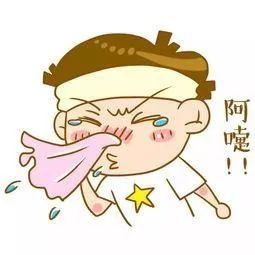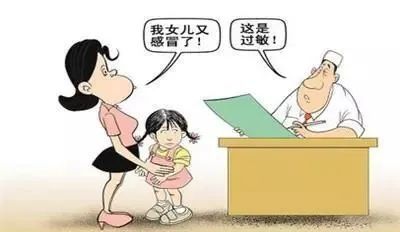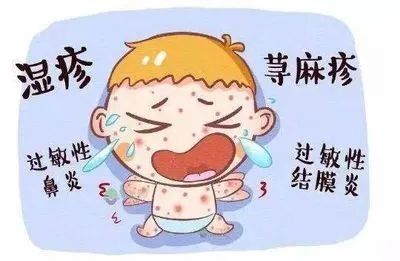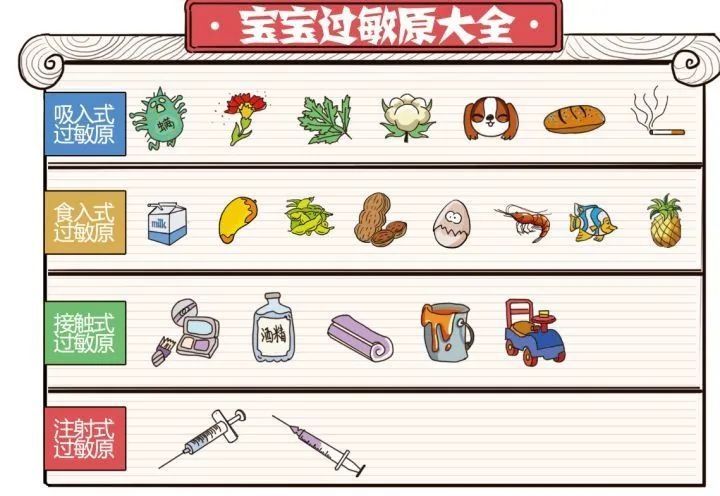rubbing eyes, sneezing
coughing, rash, stomach ache
…

Spring returns to the earth and all things recover. Children love to go to the park to play, and they inevitably come into contact with plants such as flowers and grass, and then comes allergies!
< img class="content_title" height="300" layout="responsive" sizes="(min-width: 320px) 320px, 100vw" src="https://p0.ssl.img.360kuai.com/t0124eaa9c0662b2162.jpg" width="600">
Allergy is a strong local or systemic reaction that occurs when the body is exposed to an allergen through various routes. It is an immune disease that can affect multiple systems of the body, and is a systemic disease caused by the disorder of human immune function.
Common allergic diseases in children

Allergic rhinitis
Common Symptoms include nasal itching, nasal congestion, sneezing, and runny nose. There are many similarities to a cold and it is often mistaken for a cold.
Bronchial asthma
Coughing, wheezing, shortness of breath, chest tightness, etc.
Atopic dermatitis
It is a erythematous maculopapular rash with a rough surface, large area, slightly raised, often accompanied by severe itching.

Allergic conjunctivitis
Common eye congestion, tearing, itching, burning sensation, Causes children to rub their eyes, blink, etc.
Allergic gastroenterology
It is manifested as vomiting, regurgitation, feeding difficulties, refusal to eat, abdominal pain, diarrhea, etc.
Common Allergens

Inhalation allergens
Dust mites, Pollen, pet dander, mold, etc.
Ingestion allergens
Milk, eggs, peanuts and other nuts, soybean, fish, shrimp, shellfish, mango, pineapple, etc.
Contact allergens
Plastic toys, paint, rubber, cosmetics, etc.
Injectable allergens
Injection such as penicillin and streptomycin.
Factors Influencing Allergies in Children

self factors
infants’ The immune system is immature and unbalanced, and the intestinal barrier function is not perfect.

Environmental Factors
The Hygiene Hypothesis states that the reduction of the number of bacteria in the natural environment caused by human factors, It reduces the chance of children suffering from infectious diseases, and if children’s immune systems cannot fight infection as soon as possible, they will be overdeveloped in the future, resulting in allergic reactions; Not without reason.

Hereditary factors
A history of parental allergies is a risk factor for allergies in babies.
Prevention of Allergies in Children
Avoiding allergens is the most effective preventive measure. Only by finding allergens and actively avoiding them can the occurrence of allergies be blocked from the root cause.

Yang Debin, Deputy Chief Physician of the Health Management Center of Henan Children’s Hospital, suggested that children with family history of allergies should be brought by their parents. Children should be screened for allergens (two methods commonly used in clinical practice are allergen skin prick test and serum-specific IgE detection) for targeted prevention and treatment.
If parents want to test their children for allergens, they can choose the routine + allergy screening check-up package for infants/children/teens according to the age of the child.
Allergy Screening Package Includes
General Measurements: Includes Height/Length, BodyWeight and body fat composition analysis.
Department examinations: Physical examination of children’s specialists, routine ENT examination, routine oral examination, eye health examination (vision examination, color vision examination).
Laboratory examination: Allergen detection (inhalation) contains common allergens such as dust mites, pollen, cat and dog hair, etc., screening for allergic reactions to the above substances
Allergen detection (Inedible) such as soybean, peanut, milk, egg, wheat, fish and other allergens, screening for allergic reactions to such foods
Total IGE (related to allergies, parasitic infections and skin Allergies, etc.)
Routine stool and occult blood (screening for intestinal diseases, parasites, etc., and occult blood test for gastrointestinal bleeding)
Routine blood (red blood cells, white blood cells) , platelets, etc.) to screen for common infectious diseases and blood system diseases.
Eight items of liver function (evaluation of liver function, screening for hepatitis, cirrhosis, jaundice, etc.)
Four items of renal function (evaluation of kidney function, screening of kidney disease and diabetes, etc.)
Automatic urine analysis (helps in the diagnosis of urinary tract infection, pyelonephritis, glomerulonephritis, kidney disease and other diseases).
Physical examination: color Doppler ultrasound of the upper abdomen (liver, gallbladder, pancreas, and spleen) (screening the structure, shape and size of the liver, gallbladder, pancreas, and spleen, and screening for benign and malignant lesions in each organ).
Others: health records, general inspection reports.
Health checkup is one of the effective means to discover hidden health risks and prevent diseases.
The high incidence of allergies occurs when the seasons change. The Health Management Center of Henan Children’s Hospital reminds parents and mothers to identify the high-risk factors of allergies through physical examination and screening, and to avoid contact in a targeted manner. Once you take your child outdoors, take precautions.
If your child has allergy-related symptoms, please do not blindly take medicine or ignore it. It is best to take your child to the hospital for a detailed examination, and then follow the doctor’s advice for treatment.
Source: Henan Children’s Hospital